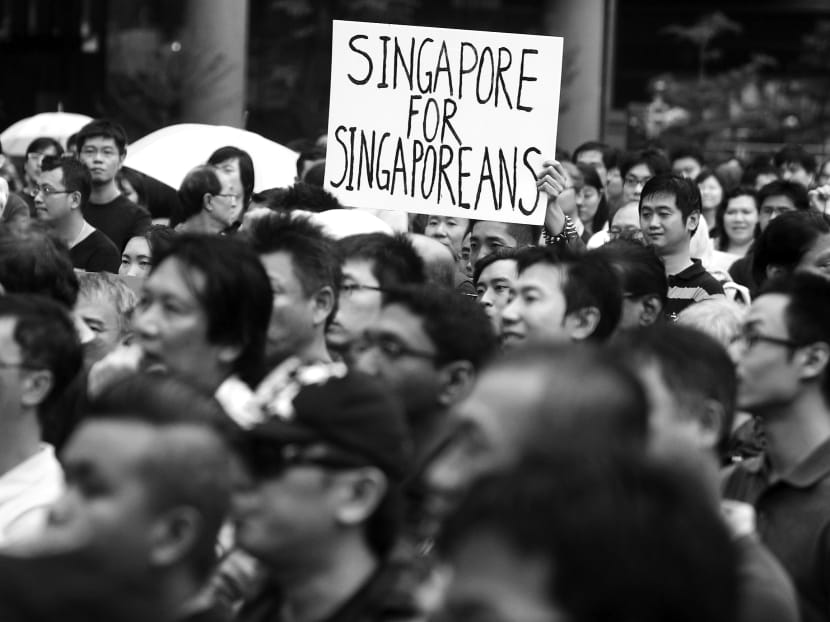Can Singapore cultivate resilience in face of change?
What makes Singapore unique? That was the question posed to a group of young professionals some years ago at a community dialogue I attended.

A protest at Hong Lim Park over the Population White Paper in February. The churning undercurrent of grievances on this issue captured the national consciousness last year. Today File Photo
What makes Singapore unique? That was the question posed to a group of young professionals some years ago at a community dialogue I attended.
With little hesitation, many cited a series of attributes that Singapore Inc was renowned for, such as public safety and strong social bonds. “We don’t have political deadlocks, unlike other democracies,” said one participant. “Singapore works impeccably,” proclaimed the other. “We complain a lot but we still support the government,” quipped the third.
Political observers will agree that the little red dot is an improbable nation that has risen above insurmountable challenges of its era; it is an epitome of a successful nation-state that has got all its policies right.
The emphasis on law and order, a harmonious multicultural community, an efficient and seamless public infrastructure, and a competent government that holds the faith and trust of the citizenry — these are all distinct legacies of the Singapore story.
It would be fair to say that until a few years ago, from the perspective of the man in the street, Singapore had ceased to be a work in progress. It had risen above the regional fray, with a compulsion to benchmark itself against an immaculate set of deliverables. It was also somewhat surreal.
A SERIES OF UNFORTUNATE EVENTS
Fast forward to 2013.
This was, in many ways, a poignant year in the modern history of the city-state. Singaporeans, already questioning the supposed infallibility of public administration — with the extraordinary escape of Jemaah Islamiyah detainee Mas Selamat in 2008, the Orchard Road floods of 2010 and the crippling breakdown of the MRT system in 2011 — were faced with a series of events that further cracked the facade of the unique Singapore story.
The churning undercurrent of grievances over the Population White Paper, the toxic haze from Indonesia, the graft trials of public figures and senior civil servants, the series of hacking incidents and the Little India riot were events that captured the national consciousness through the year. Singaporeans could no longer boast about being above the fray.
Today, a sense of doubt, pessimism, insecurity and, to some extent, despair, is palpable. The angst over the failure of our well-oiled state machinery has led some to describe the successive events over recent years as a failure of governance.
Political commentators have described the political climate after the watershed 2011 General Election and last year’s closely-fought Punggol East by-election as the new normal. Singaporeans will now have to face this new normal in governance and public administration, as well as resist measuring the country against a matrix of close-to-perfect key performance indicators.
As we progress, the state of governance can only get more challenging and our social ties more complicated and strained. Long-term planning, a linchpin of Singapore’s governance, will become nearly impossible, given the rate of change in the evolving socio-economic and geopolitical landscape.
HAVING WHAT IT TAKES
For nearly 50 years, Singaporeans from all walks of life have demonstrated remarkable resilience in the face of unwanted and unexpected change.
From the Bukit Ho Swee fire in 1961 to the 1966 Indonesian Konfrontasi and through the oil crisis of the 1970s, the recession in 1985, the Asian financial crisis in 1998 and the Jemaah Islamiyah terrorist plot in 2001, Singaporeans have arguably had their fair share of historical calamities.
These are not distant memories but real experiences, at least for the previous generation. Singaporeans have moved on at every juncture. Our forefathers had no illusions about the invincibility of the nation-state, because the existence of the country, let alone its success, was never assumed. They were not insecure. They did what they had to do to survive.
This thinking must now inform our approach to shifting goalposts in an evolving global landscape. When desired outcomes become unrealistic and non-sustainable, there must be soul-searching — much like the recent efforts by education policymakers to focus on character development, sporting abilities and community service when redefining performance indicators within the education system.
The population conundrum, the annual return of the haze, our relations with foreigners and our transport woes will continue to be multi-dimensional problems that require perseverance, tact and political compromise.
And, as the city-state matures, our obligations and responsibilities as global citizens will grow. Our efforts to define our national identity cannot stop at asking ourselves what it means to be a Singaporean today. It will have to involve cultivating national resilience — the ability to recover from setbacks and continue to do what needs to be done.
ABOUT THE AUTHOR:
Dr Leong Chan-Hoong is Deputy Head of the Institute of Policy Studies (IPS) Social Lab, an independent centre for social indicators research. He is, concurrently, a Senior Research Fellow at IPS.









